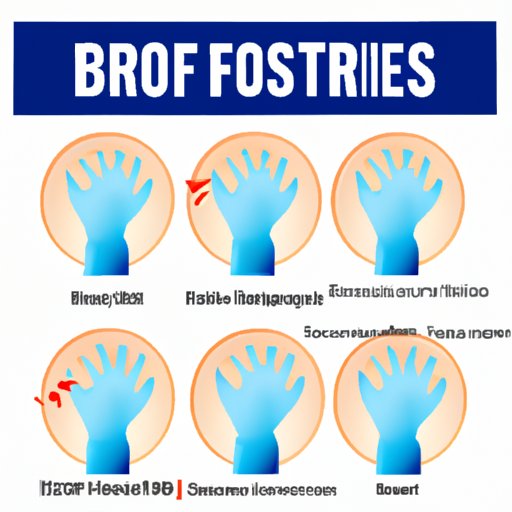
Introduction
Frostbite is a serious condition that occurs when skin and other tissues freeze due to exposure to cold temperatures. The condition is not only painful, but it can also lead to permanent damage and even amputation in severe cases. In this article, we’ll discuss how to treat frostbite and prevent it from happening in the future.
Understanding Frostbite
Frostbite occurs when the skin and other tissues freeze due to exposure to cold temperatures. As the skin and tissues freeze, blood flow to the affected area decreases, causing further damage.
Factors that contribute to frostbite include, but not limited to, prolonged exposure to cold weather and strong winds, touching extremely cold objects, not wearing warm clothing, and not using protective gear.
Common symptoms of frostbite include redness or paleness, numbness, tingling, burning, and pain in the affected area, among others. If ignored, frostbite can cause permanent damage to the affected tissues, leading to amputation and other serious medical conditions.
Basic Treatment Approaches
If you experience mild or moderate frostbite symptoms, it’s important to seek treatment immediately to prevent further damage. One of the most important things you can do is to rewarm the affected area as quickly as possible. This can be done with warm water, but not hot water (below 104°F), as soaking frostbitten skin in water that is too hot can result in burns.
If you are experiencing severe frostbite symptoms or signs of hypothermia, seek professional medical assistance immediately. While waiting for help, do not try to rewarm the affected area, as it can lead to further damage.
In addition to rewarming the affected area, taking painkillers and anti-inflammatory medication can help manage pain and swelling. Avoid smoking, drinking alcohol and anything impacts circulation, and any extreme temperature changes, as they can further damage the affected tissues. Keep the affected area elevated and protected to prevent further injury and to promote healing.
Step-By-Step Guide
Mild frostbite symptoms can be treated at home by rewarming the affected area and avoiding anything that might decrease blood flow or further damage the tissue. However, if the symptoms are moderate or severe, seek medical attention immediately.
For mild frostbite, run the affected area under lukewarm water or soak it in a warm water bath for approximately 15-20 minutes. While rewarming the affected area, don’t use sources of heat like flames, heating pads or electric blankets.
For moderate frostbite, it’s also important to seek medical attention, but meanwhile, you can manage pain and prevent further injury by following the same methods used to treat mild frostbite.
Severe frostbite requires immediate professional medical help and treatment. At this point, it’s important to avoid rewarming the affected area if you’re not around healthcare experts.
Preventing Frostbite
Preventing frostbite is a skill you can learn to keep yourself and your loved ones healthy during wintertime or any time you’re facing extreme temperatures. Before heading out, make sure that you’re properly prepared, and dress appropriately by wearing multiple layers of clothing to insulate your body. Layers should be lightweight, and should include a base layer, insulating layer, and an outer shell to protect against wind and rain.
Consume high-energy food, like nuts, chocolate, and dried fruits, to give you the fuel you need to stay warm. Drink plenty of water to stay hydrated, but avoid alcohol and caffeine, as they can lead to dehydration.
Even with proper gear, if you start to feel cold, start exercising or stop and take a break. Don’t push yourself beyond what you can handle, and don’t ignore your body’s warning signs.
Frequently Asked Questions and Resources
Here are some frequently asked questions about frostbite:
- Q: Can frostbite be permanent?
- A: Yes. Frostbite can lead to permanent damage in affected tissues and amputation in severe cases.
- Q: What can I do to prevent frostbite?
- A: Dress appropriately, keep your body warm, stay hydrated, and avoid extreme temperature changes.
- Q: How long does it take to recover from frostbite?
- A: The recovery process depends on the severity of the frostbite. Mild frostbite generally takes a few weeks to heal, while severe frostbite may take months to a year to recover from.
For more in-depth information about frostbite and its prevention, consider consulting a doctor or looking up reputable sources online.
Conclusion
Frostbite is a serious medical condition that requires immediate attention. Take great care in avoiding any factors that could contribute to it. Dress properly before heading out, stay hydrated, take frequent breaks, and learn to recognize the warning signs of frostbite and hypothermia. By following these simple tips, you can stay safe and enjoy all the outdoors have to offer without paying the price of frostbite.
Stay safe in all seasons by preparing properly for the weather and paying careful attention to your body’s signals and warnings. Remember that frostbite is preventable, and with appropriate treatment, the damage can be minimized.





